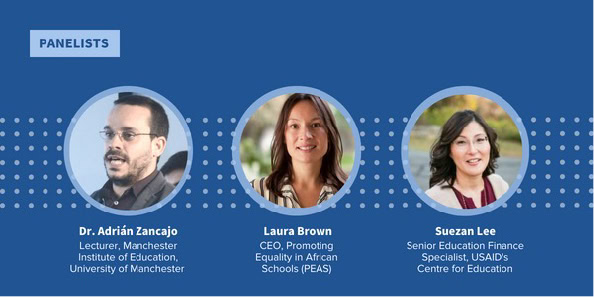Events
What does it take to develop a successful Public-Private Partnership in education?
In the first members-only Education Finance Network event, our panelists discussed evidence and experiences surrounding Public-Private Partnerships (PPPs) in education and how PPPs can contribute to improved learning outcomes for the most disadvantaged students. The panel discussion, moderated by Aashti Zaidi from the Global Schools Forum, was followed by two breakout group discussions: how to achieve equity in PPPs, and balancing autonomy and regulation in PPPs.
Key take-aways from the event:
- Evidence shows that PPPs have positively impacted access to education in low- and middle-income countries, but findings are mixed with regards to their effectiveness in contributing to learning outcomes among disadvantaged students, as in some contexts PPPs may increase learning inequalities.
- Regulation can help ensure the benefits of PPPs while promoting equity, but it is necessary to ensure capacity to monitor and enforce policies.
- A healthy PPP ecosystem requires a clear policy framework, regulatory capacity within the government, availability of high-quality private providers, and political will to learn and adapt.

Here’s a summary of the panel discussion.
PPPs help expand access but can also increase educational inequality
Dr. Adrián Zancajo presented a summary of findings from existing research, which shows clear evidence that PPPs contributed to the expansion of basic education in low- and middle-income countries. However, the findings are mixed with regards to the impact of PPPs on improving learning outcomes (for disadvantaged students in particular), in increasing diversity and innovation, and improving efficiency. The impact of PPPs on equity differs between modalities; for instance, vouchers – in particular targeted vouchers – generally have more positive effects on equity, compared to charter schools and subsidy programs.
Building trust and using local expertise
PPPs are part of a toolbox for governments to mobilize finance and improve service delivery. PPPs are often implemented in a context with limited financial, technical, and human resources where there are gaps in provision. To help ensure the success of a PPP, Suezan Lee pointed to the importance of building trust among stakeholders, ensuring stakeholder voices are heard, and leveraging local expertise, which helps tailor interventions to the local context and contributes to resilience and sustainability. Another important factor to ensure the success of PPPs is the quality of the partnership with the host country government. Government buy-in and commitment to improving non-state education is essential to success.
What makes a healthy PPP ecosystem?
Laura Brown proposed three sets of preconditions for a healthy PPP ecosystem. On the public side, the availability of a clear policy framework and the ability of the government to provide oversight of education services and accountability mechanisms are crucial. On the private side, we need a supply of socially responsible education service providers with the capacity and ability to deliver quality outcomes selected by governments in a cost-effective manner. Most importantly, the government must have the political will to learn and improve and remain committed to its policy, even if it requires adaptation over time. Governments should take into account that regulation by itself may not be sufficient to improve the equity of PPPs. Regulation requires capacity to monitor and enforce the ruling, often leaving a gap between regulation and implementation.
Five aspects that drive equity in PPPs
Promoting Equality in African Schools (PEAS) is a non-state actor providing low-cost, high-quality education in Zambia, and a USAID partner through the EduFinance project. PEAS has developed a partnership with the Ministry of Education to improve educational access and equity by increasing enrolment opportunities for secondary school students in Zambia. The PEAS model aims to ensure equity through the following approaches:
- The schools are fee-free to help reach the poorest students.
- The schools are located in areas where there is either no government provision, or inadequate government provision.
- PEAS reaches students that otherwise would not be able to go to secondary school by targeting those who have been left behind by other schools and have worse academic performance.
- Inclusion targets are written into the PPP contracts (e.g., number of girls, number of students coming from poor households, and number of students with additional learning needs).
- Teachers are performance managed by PEAS, making it easier to roll out innovations to (e.g., enroll young mothers or improve safeguarding to make their schools more attractive to marginalized groups).
Here’s a snapshot of what was discussed in the breakout rooms.
- How do we create a sustainable system when only serving populations that are low-income and underperforming?
- An important role of non-state providers is to produce the initial learning and proof points, which can then attract funding from private or public sources.
- Evidence suggests that PPPs can have the largest impact on equity for schools located in areas where there is a shortage of government schools.
- There is a tendency for low-fee private schools to see the negative side of regulation but schools receive several benefits from registering with the government. For example, in one country, registered schools received additional government resources, including access to personal protective equipment during the COVID-19 pandemic.